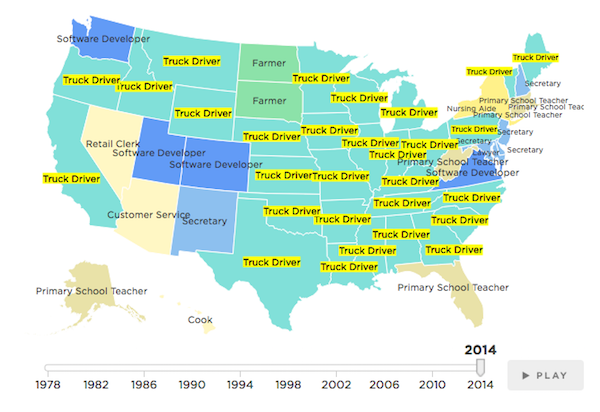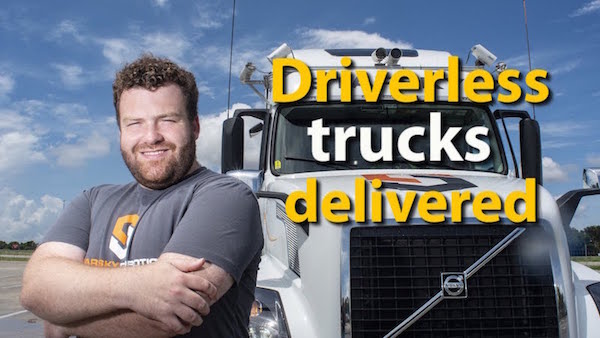The Christian Science Monitor recently took a good long look at how the automated future will affect workers in one of the nation’s largest job categories — trucking. Self-driving vehicles will likely cause a great number of the two million-plus truck drivers in America to be put out of work.
Below, a 2015 map of employment in the US from National Public Radio (NPR) shows the most common occupation in every state, where truck driving now predominates.

It’s interesting to look at NPR’s chart of “Common Jobs” that accompanies the map above: in 1978, for example, Secretary was a top employment category, but office technology has already reduced the number of persons in that job with more reductions to come.
It would be nice if official Washington were paying attention to the fundamental economic changes coming our way from the automation wave. There’s not a whole lot that can be done, since machines will be utilized whenever they become cheaper than humans. Still, an emphasis on appropriate technical training would help, and of course we needn’t be importing foreign workers when nearly half of Americans will be made jobless in 20 years if the forecast of Oxford researchers is correct. Therefore:
Automation Makes Immigration Obsolete
The Christian Science Monitor looked at the technology largely from the viewpoint of the drivers who will be affected, which is a pleasant change from the Silicon Valley opinion that any tech advance is totally cool, no matter the human consequences.

Self-driving trucks in US offer window into where machines may replace humans, Christian Science Monitor, November 14, 2018
POMPANO BEACH, FLA. — On a muggy morning, Matt Brauneck noses his semi with its 53-foot trailer out of the yard, past the puddles left by a tropical storm. From his driver’s seat in the cab he has a clear view of the road and of the light suburban traffic leading to Interstate 75 in southeastern Florida. Atop the pearly-white cab are six cameras and three radar sensors that are feeding data to a computer stack behind Mr. Brauneck’s seat and to a remote operating base in Jacksonville, Fla., 300 miles away. Brauneck’s boss, Stefan Seltz-Axmacher, the head of a small robotics company, is wedged in the back. I’m sitting up front.
And we’re about to turn over command of 16 tons of aluminum and steel to an algorithm.
After the truck eases onto the highway, Brauneck talks into his headset to the technicians in Jacksonville. Ten minutes later he gets the all-clear: Time to engage automation. He turns a cracker-sized red knob on the dashboard and flicks a switch. “We’re rolling. It’s on,” he says.
Brauneck lifts his hands from the wheel, which jerks occasionally to correct our path. The accelerator pedal at his feet is working itself up and down, or so it seems, as we cruise along I-75. Brauneck says the first time he “drove” a truck in automation it felt like the first time he scuba dived. Like breathing underwater, “it didn’t feel right,” he says. Now it’s routine for him.
Yet it’s not routine for me. I can’t stop watching the twitching wheel. Outside, the narrow highway shoulder is hemmed by a 10-foot fence to keep out alligators from the surrounding swampland. I see vultures wheeling overhead – seriously.
Welcome to tomorrow on the nation’s highways. Your local truck stop is one of the latest places where machines may soon replace jobs now done by humans.
For decades, robotic devices have been remaking the world of work, principally on the factory floor. They build our cars. They fetch our TVs and toasters in massive consumer warehouses. They weld the turbines used in jet engines.
But with advances in artificial intelligence, machines are poised to invade workplaces that once seemed immune to automation. A 2013 study by Oxford University found that fully 47 percent of jobs in the United States were at risk of being automated based on existing AI and robotics capabilities.
Transportation is one of the key areas where machines are on the march. People are both captivated – and frightened – by the prospect of self-driving cars pulsing through the nation’s streets. But for all the hype about automated cars, trucks may well begin hauling freight along highways, without the grizzled trucker at the wheel, first. Highway driving is more straightforward to automate than unpredictable urban driving and holds the promise of lower fuel costs, higher productivity, and improved safety.
Automated trucking is already a reality in remote mines and logging camps, and the US military has built its own robo-trucks to deploy in war zones. Volvo recently unveiled a prototype of an electric self-driving truck that doesn’t even have a cab for a driver.
While all this represents progress to many people, others worry about a looming loss of jobs. Andrew Yang, an entrepreneur and author of a book on automation, says AI could replace millions of semi-skilled humans in industries from fast food to retail. No job is immune, not even in white-collar fields such as accounting, insurance, and pharmacology.
“People talk about this as if it’s speculative and in the future, and we’re in the midst of it,” says Mr. Yang.
That warning may be premature – or prescient. What can the trucking industry tell us? (Continues)


